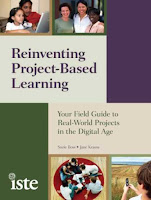
In the book Reinventing Project-Based Learning by Suzie Boss and Jane Krauss there were two elements of Project Based Learning that really resonated with me that I am excited to implement to help me bring my teaching into the twenty-first century. Chapter seven discussed strategies for keeping a project flowing and working through pitfalls, and chapter nine gave strategies and examples of how to create meaningful and authentic assessment for students. In addition to those two big ideas, the book also offered many new technologies and resources that are available for educators such as wiki pages, blogs, podcasting, screencasting, and online forums that I was not aware existed. I am very excited to bring these technologies back to my classroom and work to implement them in the fall.
The idea of creating and implementing projects for students is not a new one, and I often do project work in my classroom. In my attempts to create successful projects I have encountered many roadblocks along the way, some that I was able to overcome and some that caused me to give up on a project before students completed it. In chapter seven Boss and Krauss explain several aspects of how to set up a project to prevent pitfalls, and how to keep the project going when a pitfall is encountered. In the second paragraph on page 113 the authors give a case study where teachers worked to create this great lab setting and asked a question they thought was wonderful only to have students walk over to google and find the answer in a matter of seconds. I loved the idea from that scenario that good projects are based on a question that cannot be answered just by going to google. A good project needs to be designed to encourage debate, struggles, and experimentation between students that teaches them new ways to view the world around them. Later in chapter seven on page 122 a teacher Michael McDowell states that the traditional classroom leaves no room for students to fail and provides shallow risk free learning. That statement really resonated with me, in combination with the idea that projects that I create need to involve debate and controversy. In future projects I will use self-assessment during planning to test my essential questions on google to see if they can easily be answered or if they will spark debate and a real project based experience.
Another idea in chapter seven that caught my interest was the strategies for how to improve team dynamics. This past year I designed a project where my third grade classes worked together to compose and perform a musical. During the script writing process I had them work in groups several classes in a row and I switched the team members that worked together each class session. In one of my classes I had a few students that it did not matter which group I put them in, they were always fighting with the other students and their classmates were constantly calling me over to let me know that they were not sharing, participating, and cooperating. I loved the teamwork building strategies on pages 123 and 124 such as a using a teamwork contract, keeping a commentary on teamwork in a journal, filling out a teamwork-scoring rubric, and filling out a self-assessment focusing on the assets each student had to offer a team. I plan to implement these team building strategies when I go back and I am eager to see if these strategies help with the management piece of teaching, so that more of my time is spent on asking questions and broadening understanding instead of fixing problems that arise.
In chapter nine there are numerous examples of how to design and implement assessments for class projects. On page 144 Carmel Crane explains that the most important aspect of assessment is that it provides “feedback that matters to [students]”. If I want to create passion based learning it will be important for me to figure out how to design the project and assessments so that students reach my end goal in a way that is meaningful to them. I believe that creating authentic meaningful assessments will encourage students to see how the learning we do in the classroom relates to real life and will create a lasting impact on their learning.
No comments:
Post a Comment